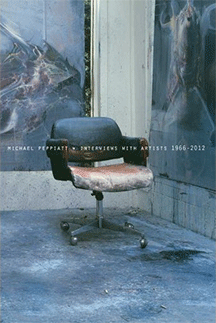By Svetlana Alpers
Michael Peppiatt is a British art critic, editor, and curator. In 1964, after finishing university, he went to Paris where he lived and worked for thirty years until he returned to London in the mid-1990s. This austere, elegantly designed book brings together forty-five conversations with artists—mostly European and English, many having become friends of the author. Some are printed as dialogues, others as distilled monologues. Brief introductions in italic typeface describe the ambience—human, spatial, intellectual—of the meetings. The only illustrations are subtle photographs of the artist in the studio.
That account makes the book sound cool. It is. All the more so, perhaps, to emphasize the verbal content that is hot with passion for art. One need not share Peppiatt’s tastes (Francis Bacon is a top favorite) to be won over by his curiosity about and sympathy for the artist making art. And the record is that artists respond because they are not hectored, but rather drawn out into talking.
One remembers sites where the conversations took place: Balthus high up in the Villa Medici gazing out over Rome; Piero Guccione on the coast of a parched Sicily living to paint the sea; Sean Scully at a farm in snowy Bavaria, the colors of his canvases so evident in wintry light.
And one remembers words that often address the general condition of art in our world:
“The trouble is that nowadays, and nowhere more so than in the United States, artists have become more concerned with presenting their work than creating it. They’ve got two quite separate functions muddled up. Creating is antisocial . . . but the whole business of presenting one’s work to the public is a highly social activity. Some artists get so completely caught up in presenting their work that they become like stars—the very opposite of inventors.”
That was Jean Dubuffet speaking in 1977. His prophetic words are even truer today when instead of serving as a retreat the studio has become a site of performances made for installation as such in a gallery or a museum.
Like Dubuffet, Sean Scully has remained a painter in the studio. “Above all the thing about being here,” he says of his Bavarian studio, “is that it remains very private.” However, he goes on to speak of his paintings as bridges that take him out of himself. A consummate colorist, he replies to Peppiatt’s question about his consciousness of the way other painters use color with a memorable account of Velázquez’ Las Meninas: “. . . the beautiful use of pinks and greys in his Infanta, the beautiful greys that make the dress look like a prison for the body that is in it.” Scully’s sense of breaking out or through, much as his colors do, pervades the conversation which ends with his declaration that he feels he is fighting for painting: “I’m not in easy-going co-existence with a lot of other art forms . . . . I myself don’t think of painting as being traditional. I always think of it in terms of how dynamic it is and what its possibilities are.”
This book is of particular times and places. Sonia Delaunay and Ida Barbarigo are the only women included. Though Cartier-Bresson and Henry Moore make an appearance, most of the artists are painters. It makes one want to go and look at what they made. In addition, as Peppiatt puts it in the introduction, it adds up to “a kind of weird, patchy but exalting autobiography.”
Svetlana Alpers, an artist, critic and renowned art historian, is professor emerita of the history of art at the University of California, Berkeley and a visiting scholar in the Department of Fine Arts at New York University.




